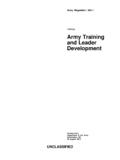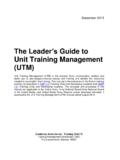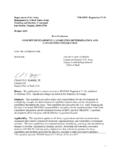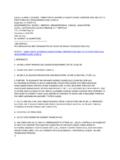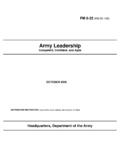Transcription of 19960815 145 - Defense Technical Information Center
1 ARI Research Note 96-631996 army Symposium: "LeadershipChallenges of the 21st Century army "Executive SummaryJames G. (Jerry) Hunt and Robert L. PhillipsTexas Tech UniversityArmy Trends Analysis GroupAlma G. Steinberg, ChiefMay 199619960815 145 United States ArmyResearch Institute for the Behavioral and Social SciencesApproved for public release; distribution is army RESEARCH INSTITUTEFOR THE BEHAVIORAL AND SOCIAL SCIENCESA Field Operating Agency Under the Jurisdictionof the Deputy Chief of Staff for PersonnelEDGAR M. JOHNSOND irectorResearch accomplished under contractfor the Department of the ArmyTexas Tech UniversityTechnical review byBeveraly C. HarrisNOTICESDISTRIBUTION: This report has been cleared for release to the Defense Technical InformationCenter (DTIC) to comply with regulatory requirements.
2 It has been given no primary distributionother than to DTIC and will be available only through DTIC or the National Technical InformationService (NTIS).FINAL DISPOSITION: This report may be destroyed when it is no longer needed. Please do notreturn it to the army Research Institute for the Behavioral and Social : The views, opinions, and findings in this report are those of the author(s) and should notbe construed as an official Department of the army position, policy, or decision, unless sodesignated by other authorized DOCUMENTATION PAGE1. REPORT DATE 2. REPORT TYPE 3. DATES COVERED ( to)1996, May Final March 1996-June 19964. TITLE AND SUBTITLE 5a. CONTRACT OR GRANT NUMBERDASWO-96-M-16701996 army Symposium: "Leadership Challenges of the 21st Century 5.
3 PROGRAM ELEMENT NUMBERArmy" Executive Summary 0605803A6. AUTHOR(S) 5c. PROJECT NUMBERD730 James G. (Jerry) Hunt and Robert L. Phillips (Texas Tech University) 5d. TASK NUMBER11335e. WORK UNIT NUMBERCO17. PERFORMING ORGANIZATION NAME(S) AND ADDRESS(ES) 8. PERFORMING ORGANIZATION REPORT NUMBERI nstitute for Management and Leadership ResearchTexas Tech Box 4670 0002 ABLubbock, TX 79409-10359. SPONSORING/MONITORING AGENCY NAME(S) AND ADDRESS(ES) 10. MONITOR army Research Institute for the Behavioral and Social Sciences ARIATTN: PERI-TA5001 Eisenhower Avenue 11. MONITOR REPORT NUMBERA lexandria, VA 22333-5600 Research Note 96-6312. DISTRIBUTION/AVAILABILITY STATEMENTA pproved for public release; distribution is SUPPLEMENTARY NOTESCOR: Beverly C.
4 Harris14. ABSTRACT (Maximum 200 words):The 1996 army Leadership Symposium: "Leadership Challenges of the 21st Century army " was held at Cantigny Estate, Wheaton,Illinois from 27-29 March 1996. The symposium brought together senior army leaders and noted academics to discuss the keyleadership and leader development issues facing the army as it moves into the 21st century. This report summarizes the event anddocuments the key issues identified during the discussions. These issues primarily concern defining the operational environment ofthe future, the implications for leadership and leader development as a result of the changing technology and missions, and theimplications for leadership and leader development research to ensure a strong theoretical and research base for the army 's leaderdevelopment plans and programs.
5 Discussions also emphasized the need to maximize human potential and maximize the benefitsfrom leader development SUBJECT TERMSL eadership Organizational change Leader development army leadersSECURITY CLASSIFICATON OF 19. LIMITATION OF 20. NUMBER 21. RESPONSIBLE PERSONABSTRACT OF PAGES (Name and Telephone Number)16. REPORT 17. ABSTRACT 18. THIS PAGEU nclassified Unclassified Unclassified Unlimited 30 Dr. Beverly C. Harris(703) 617-0367In MemoriumColonel (Ret.) Dandridge M. (Mike) Malone, USA1 January 1930 to 15 December 1995 Mike Malone began his army career as a private and ended as a colonel almost 30 yearslater. During that time, he gained a degree from Vanderbilt University and an FromPurdue, and graduated from the army 's Command and General Staff College and the army WarCollege.
6 Renowned as the army 's expert on leadership, both in garrison and in combat, he taughtthe subject to noncommissioned officers, West Point cadets, and students at various army serviceschools, including the army War College. Audio and video tape versions of his leadershipaccount, "Soldier," exceed 100,000 copies in circulation among army troop units worldwide,and continue to bring Malone's lesson on leadership to commanders everywhere. His 1983 book,"Small Unit Leadership: A Common Sense Approach," remains a peerless masterpiece of troopleadership philosophy and technique. Mike Malone was the person questioning our army duringthe 1970's when we began to stray from focusing on the essence of our army --our soldiers.
7 Hetaught us, encouraged us, and challenged us. Soldiers are our credentials--Mike Malone madesure we never forgot 1996 army Symposium: "Leadership Challenges of the 21st Century army " wascosponsored by the Commanding General, army training and Doctrine Command(TRADOC), and the Deputy Chief of Staff for Personnel (DCSPER). The symposium wasdedicated to Colonel (Ret.) Dandridge M. (Mike) Malone, USA, for his contributions toleadership, to soldiers, and to the army . The army Research Institute for the Behavioraland Social Sciences (ARI) and the Human Resources Directorate of the DCSPER planned andcoordinated the event, and a total of 37 senior army leaders and 15 academics participated todiscuss the critical leadership and leader development issues facing the army over the next 10years.
8 In conjunction with ARI, Dr. Jerry Hunt and Dr. Robert Phillips from Texas TechUniversity selected the academic scholars to participate and coordinated the development of 12draft research papers to contribute to the discussions at the symposium and to be expanded andfinalized as a scholarly book to be published later this army has an excellent leader development system that has functioned well in the conferences have explored leadership and leader development issues, and scholarlybooks have been published from these conferences over the years. Why have another one; whynow? Since 1991, the army has lost almost half of its human capital, operating budgets continueto be reduced, the political climate supports the continuing reductions of personnel and dollars,and the nature of the threat to America and world peace has changed.
9 Senior army leadersrecognize the urgency of going beyond simply responding to the call to reduce people and symposium was designed to take a proactive approach by addressing a key critical question:How do we anticipate the future and develop leaders to handle technology, the complexenvironment, and the challenges of the future?This report describes the symposium and synthesizes the various issues, discussions, andrecommendations that came out of the exchange between senior army leaders and academicscholars. Issues and recommendations focused primarily on defining the future operatingenvironment and effective leadership; evaluating the leader development system--what do we doright, what needs streamlining or improvement, and what needs to be added; and identifyingcritical research issues to link the selection, development, assessment, and utilization processes tosound theory and is dedicated to sponsoring and conducting research to inform not only the scientificand theoretical aspects of leadership, but the practical, operational aspects so critical to individual,unit, and army effectiveness.
10 A number of innovative ideas and recommendations came from thisiiisymposium that address change involving many parts of the army . As partners, the research,institutional, and operational army can increase efficiency, improve effectiveness of the currentsystems, and build new systems on a solid foundation to ensure that the future army remainstrained and M. SIMUTIS EDGAR M. JOHNSOND eputy Director Director(Science and Technology)iv1996 army SYMPOSIUM: "LEADERSHIP CHALLENGES OF THE 21 ST CENTURYARMY,"CONTENTSPageIN T R O D U C T IO N .. 1 OVERVIEW AND ACCOMPLISHMENTS .. 2K E Y IS S U E S .. 3 The Future O perating Environm ent .. 3L eadership P olicy Issues .. 4L eader D evelopm ent Issues.










